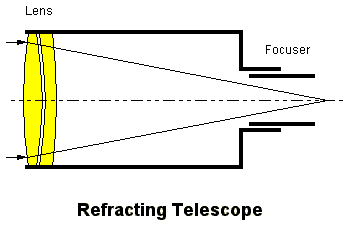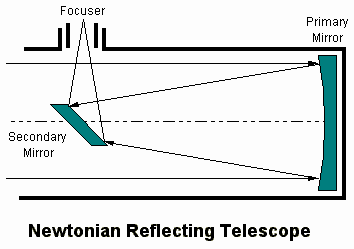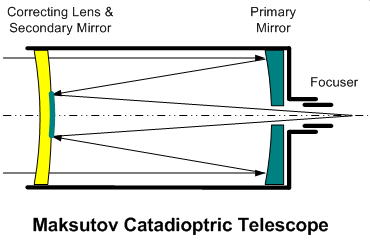Types of Telescopes:
Refractors: The refracting telescope was invented in 1608 by Dutch lens maker Hans Lippershey (originally for military purposes), and the following year Galileo Gallilei became the first astromnomer to use it to observe the skies. In a refracting telescope, lenses are employed to collect and focus light coming from the outside. Light enters through the objective lens (the big lens at the end of the telescope) and focuses down the length of the primary telescope tube. At the end of the telescope, an eyepiece lens then magnifies the resulting image. Refractors are relatively uncomplicated mechanisms compared to some other types of telescopes, which make them a good choice for beginners (although they can be expensive compared to telescopes with similar capabilities). Refractors have what are known as focal ratios. Focal ratios are determined by dividing the diameter of the objective lens (or mirror for other telescope types) by the distance it takes the lens or mirror to form an image. Longer focal ratios (f/10 and above) create sharper contrasts, while shorter focal ratios, like f/4 or f/5, allow for wider fields of view and more sensitivity to light. Since refractors usually have longer focal ratios, they are generally regarded as better telescopes for tasks such as observing the Moon, the planets, or certain types of stars, like double stars (which need sharp contrasts to seperate two stars in your telescope.)

Reflectors: Instead of lenses, a reflector telescope uses mirrors to collect and focus light. Light enters the telescope at the front and hits a curved, parabolic mirror at the back of the telescope, which sends it back towards a second smaller flat mirror close to the front of the scope. This secondary mirror then sends the light to the eyepiece lens, which then magnifies the resulting image. The first reflector telescope design was by Sir Isaac Newton and most refelectors that are used by amateurs are Newtonians. Reflectors generally have focal ratios of between f/4 and f/8, which make them good telescopes for looking at faint or distant objects like clusters, galaxies or nebulae. They're also relatively inexpensive compared to other types of scope. Some of the drawbacks include the fact that they're not very useful for looking at anything other than the sky, and the fact that, thanks to an open tube, reflectors are liable to gather dust and imperfections over time, which will compromise image quality.

Catadioptrics: A catadioptric telescope uses both lenses and mirrors to collect and focus light. Two of the most popular variations of this type of telescope are the Schmidt-Cassegrains and Maksutov-Cassegrains (these two types differ in the type of corrector lens that is used at the front of the scope to increase the field of view). The Cassegrain telescope was first published in an 1672 design attributed to Laurent Cassegrain. It has a parabolic primary mirror, and a hyperbolic secondary mirror that reflects the light back down through a hole in the primary. Folding and diverging effect of the secondary creates a telescope with a long focal length while having a short tube length. These telescopes inhabit a middle ground between refelectors and refractors in terms of price and focal ratio, and most offer the additional advantage of being relatively compact, and therefore, somewhat easier to lug from place to place.
